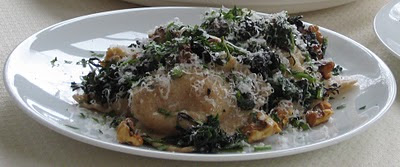We made this using greens from our CSA box, including baby red mustard greens and nettles...which, two stings later (from preparing them, not eating them), I'm not sure I'd exactly actively seek out in the future for cooking myself. If you do use nettles, a pair of powder-free latex gloves is a lovely thing to have on hand...literally. Rinse the nettles, pick the leaves off the stems carefully, and then soak the leaves in slightly warm water for a few minutes. Drain, then cook. Cooking takes the sting out, and they taste wonderful. But this might be an ingredient best enjoyed at a restaurant when someone else is handling the food preparation. (Pizzaiolo, in Oakland, is still one of our favorite pizza places ever, and they will put nettles on your pizza. And you will, in turn, declare your undying love for their pizza oven. Or at least, we did.) You could use baby arugula, spinach, and/or amaranth greens here as well -- pretty much anything that doesn't require a long cooking time.
Ingredients
Multigrain pappardelle or fettuccine
1/3-1/2 pound mild Italian lamb sausage meat (or other sausage)
3/4 cups finely chopped shallot
2 cloves garlic, pressed
Slightly over 3/4 lbs crimini mushrooms, sliced
Slightly over 1/4 lbs shiitake mushrooms, sliced
Salt and freshly ground black pepper
2 tbsp sherry
1/4 cup veggie broth
2-3 handfuls of greens, chopped
2 handfuls flat leaf parsley, chopped
Shaved Parmesan cheese
Bring a pot of salted water to a rolling boil for the pasta.
Heat a bit of olive oil in a wide pan with deep sides over high heat. Add the sausage and brown lightly, breaking into pieces with a spatula. When the pieces are golden brown on one or two sides, push to the side of the pan and turn the heat down to medium. Add the shallot to the opposite side and stir, cooking, for about two more minutes until the shallot is soft. Add the garlic, stir once or twice, wait a moment, then add the mushrooms and mix everything together. Stir and cook, adding a couple pinches of salt and a liberal dousing of black pepper, until the mushrooms begin to soften and release their juices (you may have to sprinkle them with a little olive oil to get them going). Add the sherry, stir, and saute for a moment more. Next, add the greens and veggie broth and saute briefly until they wilt, then stir in most of the parsley (adjust amount to taste) and turn off the heat.
Meanwhile, add the pasta to the boiling pot of water, stir, and cover to bring back to a boil quickly. Boil for about 3 minutes (for pappardelle) or until al dente. Just before you drain it, remove a ladleful of water and reserve for the sauce.
 Drain the noodles mostly but not completely, and then pour them into the pan with the sauce. Drizzle with a little olive oil, then toss gently to combine with the mushrooms, adding some extra pasta water if necessary.
Drain the noodles mostly but not completely, and then pour them into the pan with the sauce. Drizzle with a little olive oil, then toss gently to combine with the mushrooms, adding some extra pasta water if necessary.Serve hot, with extra parsley and the shaved Parmesan sprinkled over.
Serves 3-4.
Pairs very, very well with Moshin Vineyard's current red blend, which is some sort of delightful Zin-meets-Syrah-with-a-splash-of-Pinot type of affair.





















